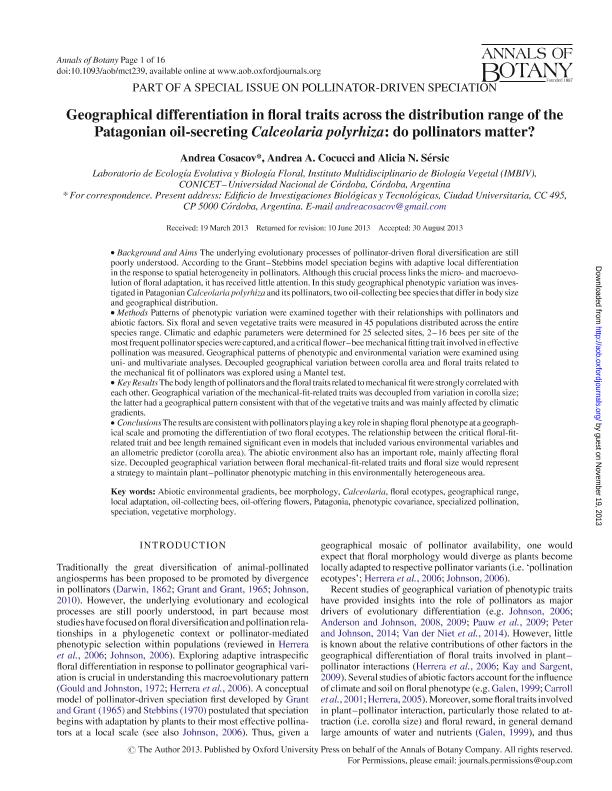Mostrar el registro sencillo del ítem
dc.contributor.author
Cosacov Martinez, Andrea

dc.contributor.author
Cocucci, Andrea Aristides

dc.contributor.author
Sersic, Alicia Noemi

dc.date.available
2015-07-21T17:05:53Z
dc.date.issued
2013-09
dc.identifier.citation
Cosacov Martinez, Andrea; Cocucci, Andrea Aristides; Sersic, Alicia Noemi; Geographical differentiation in floral traits across the distribution range of the Patagonian oil-secreting Calceolaria polyrhiza: Do pollinators matter?; Oxford University Press; Annals of Botany; 113; 2; 9-2013; 251-266
dc.identifier.issn
0305-7364
dc.identifier.uri
http://hdl.handle.net/11336/1344
dc.description.abstract
Background and Aims: The underlying evolutionary processes of pollinator-driven floral diversification are still poorly understood. According to Grant-Stebbins model speciation begins with adaptive local differentiation in response to spatial divergence in pollinators. Despite this crucial process links the micro- and macroevolution of floral adaptation, has received relatively poor attention. We studied geographical phenotypic variation of the Patagonian Calceolaria polyrhiza and its pollinators, two oil-collecting bee species that differ in body size and geographical distribution. Methods: We examined geographical pattern of phenotypic variation and its relationship with pollinators and abiotic factors. Six floral and seven vegetative traits were measured in 46 populations distributed across the entire species range. We selected 24 sites and retrieved their climatic and edaphic parameters; we captured 2-16 bees/site of the most frequent pollinator species and measured a critical flower-bee fitting trait involved in effective pollination. Geographical patterns of phenotypic variation and environmental variation were examined using uni- and multivariate analyses. Mantel permutation test was used to explore decoupled geographic variation between corolla area and fit-related floral traits. Key Results: Body length of pollinators and floral fit-related traits were strongly correlated with one another. Geographic variation of mechanical-fit related traits is decoupled from variation in corolla size. This latter floral trait has a geographical pattern consistent with that of vegetative traits and is mainly affected by climatic gradients. Conclusions: In this system pollinators play a key role in shaping floral phenotype at a geographical scale, promoting the differentiation of two floral ecotypes. The relationship between floral fit-related trait and bee length remained significant even in models that included various environmental variables and an allometric predictor (corolla area) one. The abiotic environment also has an important role, mainly affecting floral size. Decoupled geographical variation between fit-related traits and floral size is suggested to represent a strategy to maintain plant-pollinator phenotypic matching in this environmentally heterogeneous area.
dc.format
application/pdf
dc.language.iso
eng
dc.publisher
Oxford University Press

dc.rights
info:eu-repo/semantics/openAccess
dc.rights.uri
https://creativecommons.org/licenses/by-nc-sa/2.5/ar/
dc.subject
ABIOTIC ENVIRONMENTAL GRADIENTS
dc.subject
BEE MORPHOLOGY
dc.subject
CALCEOLARIA
dc.subject
FLORAL ECOTYPES
dc.subject
GEOGRAPHICAL RANGE
dc.subject
LOCAL ADAPTATION
dc.subject
OIL-COLLECTING BEES
dc.subject
OIL-OFFERING FLOWERS
dc.subject
PATAGONIA
dc.subject
PHENOTYPIC COVARIANCE
dc.subject
SPECIALIZED POLLINATION
dc.subject
SPECIATION
dc.subject
VEGETATIVE MORPHOLOGY
dc.subject.classification
Ciencias de las Plantas, Botánica

dc.subject.classification
Ciencias Biológicas

dc.subject.classification
CIENCIAS NATURALES Y EXACTAS

dc.title
Geographical differentiation in floral traits across the distribution range of the Patagonian oil-secreting Calceolaria polyrhiza: Do pollinators matter?
dc.type
info:eu-repo/semantics/article
dc.type
info:ar-repo/semantics/artículo
dc.type
info:eu-repo/semantics/publishedVersion
dc.date.updated
2016-03-30 10:35:44.97925-03
dc.journal.volume
113
dc.journal.number
2
dc.journal.pagination
251-266
dc.journal.pais
Reino Unido

dc.journal.ciudad
Oxford
dc.description.fil
Fil: Cosacov Martinez, Andrea. Consejo Nacional de Investigaciones Científicas y Técnicas. Centro Científico Tecnológico Conicet - Córdoba. Instituto Multidisciplinario de Biología Vegetal. Universidad Nacional de Córdoba. Facultad de Ciencias Exactas Físicas y Naturales. Instituto Multidisciplinario de Biología Vegetal; Argentina
dc.description.fil
Fil: Cocucci, Andrea Aristides. Consejo Nacional de Investigaciones Científicas y Técnicas. Centro Científico Tecnológico Conicet - Córdoba. Instituto Multidisciplinario de Biología Vegetal. Universidad Nacional de Córdoba. Facultad de Ciencias Exactas Físicas y Naturales. Instituto Multidisciplinario de Biología Vegetal; Argentina
dc.description.fil
Fil: Sersic, Alicia Noemi. Consejo Nacional de Investigaciones Científicas y Técnicas. Centro Científico Tecnológico Conicet - Córdoba. Instituto Multidisciplinario de Biología Vegetal. Universidad Nacional de Córdoba. Facultad de Ciencias Exactas Físicas y Naturales. Instituto Multidisciplinario de Biología Vegetal; Argentina
dc.journal.title
Annals of Botany

dc.relation.alternativeid
info:eu-repo/semantics/altIdentifier/url/https://academic.oup.com/aob/article/113/2/251/2768981
dc.relation.alternativeid
info:eu-repo/semantics/altIdentifier/doi/http://dx.doi.org/10.1093/aob/mct239
Archivos asociados
